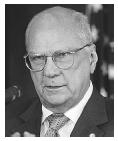NICARAGUA
Enrique Bolaños Geyers
President

(pronounced "en-REE-kay bo-LAH-nyos GUY-ers")
"No one will be above the law in my government. Everybody knows I am a man of integrity."
The Republic of Nicaragua is the largest and least densely populated country in Central America. Approximately the size of New York State, the 120,254 sq km region (74,738 sq mi) is home to 5,023,818 inhabitants (2002 estimate). With the Pacific Ocean on the west coast and the Caribbean Sea on the east coast, Nicaragua lies between Honduras in the north and Costa Rica in the south. The capital city of Managua has a population of approximately 1,093,760. Comprised of a mainly mestizo (mixed Amerindian and Caucasian) populus (69%); the population also includes a significant number of whites (17%), blacks (9%), and Amerindians (5%) in the country. While most whites live in Managua, blacks and Amerindians are concentrated on the east coast. Roman Catholics comprise 85% of the population and the remaining 15% are Protestant. Spanish is the official language, but English is widely spoken on the Caribbean coast and in Managua. Life expectancy at birth was 69 years as of 2002. Infant mortality remains high at 33 deaths per 1,000 live births, though it has been decreasing. Literacy (defined as the population above the age of 15 that can read and write) was estimated at 68% in 2002.
The unit of currency is the gold cordoba. The per capita gross domestic product (GDP) was approximately US $2,700 in 2000. From 1996–2001, the GDP steadily increased (in 2001, it rose 5%, though with an inflation rate of 11%, even this level of growth was limited). Until 1998, Nicaraguan efforts to instill economic stability had paid off—reforms were reaping some success, even amidst the muddied waters the legacy of civil war and years of financial mismanagement had left behind. Then came Hurricane Mitch in 1998, devastating Nicaragua and neighboring Honduras and leaving Nicaragua, already the poorest country in Central America, with US $1 billion worth of damage. Worst hit was the agricultural sector, which the country depends on for the majority of its exports. By 1999, Nicaragua was forced to deal with a trade deficit approaching US $970 million. Despite the destruction caused by Hurricane Mitch, Nicaragua's economy has continued to grow. Aid and debt relief have contributed to this and helped to stabilize the economy.
Nicaragua is still the second-poorest nation in the hemisphere, and the poorest in Central America, with approximately 50% of the population living below the poverty line.
ADDRESS
Office of the President of the Republic of Nicaragua
Casa de Gobierno
Antiguo Banco Central
Managua, Nicaragua
Comment about this article, ask questions, or add new information about this topic: